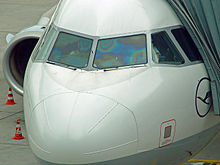Thin-film optics




Thin-film opticsis the branch ofopticsthat deals with very thin structured layers of different materials.[1]In order to exhibit thin-film optics, the thickness of the layers of material must be similar to thecoherence length;for visible light it is most often observed between 200 and 1000nmof thickness. Layers at this scale can have remarkable reflective properties due to light waveinterferenceand the difference inrefractive indexbetween the layers, the air, and the substrate. These effects alter the way the opticreflectsandtransmitslight. This effect, known asthin-film interference,is observable insoap bubblesand oil slicks.
More general periodic structures, not limited to planar layers, exhibitstructural colorationwith more complex dependence on angle, and are known asphotonic crystals.
In manufacturing,thin filmlayers can be achieved through thedepositionof one or more thin layers of material onto a substrate (usuallyglass). This is most often done using aphysical vapor depositionprocess, such asevaporation depositionorsputter deposition,or a chemical process such aschemical vapor deposition.
Thin films are used to createoptical coatings.Examples includelow emissivitypanes ofglassfor houses and cars,anti-reflective coatingsonglasses,reflective baffles on car headlights, and for high precisionoptical filtersandmirrors.Another application of these coatings isspatial filtering.[2]
Examples in the natural world
[edit]-
The breast feathers of theLawes's parotia.[4]
-
Thethin-film interferencethat can be seen on manyinsect wingsis due to thin-film optics.
Thin-film layers are common in the natural world. Their effects produce colors seen in soap bubbles and oil slicks, as well as thestructural colorationof some animals. The wings of many insects act as thin-films, because of their minimal thickness. This is clearly visible in the wings of many flies and wasps. In butterflies, the thin-film optics is visible when wing itself is not covered by wing scales, which is the case in the blue wing spots of theAglais ioand the blue-green patches of theGraphium sarpedon.[3]Inbuttercups,the flower's gloss is due to a thin-film, which enhances the flower's visibility topollinatinginsects and aids in temperature regulation of the plant's reproductive organs.[5]
See also
[edit]- Dichroic filter
- Dichroic prism
- Dielectric mirror
- Dual polarisation interferometry
- Fresnel equations
- Thin-film interference
- Transparent materials
References
[edit]- ^Knittl, Z. (1981).Optics of thin films.John Wiley.
- ^Moreno, Ivan; Araiza, JJ; Avendano-Alejo, M (2005). "Thin-film spatial filters".Optics Letters.30(8): 914–6.Bibcode:2005OptL...30..914M.doi:10.1364/OL.30.000914.PMID15865397.S2CID2259478.
- ^abcStavenga, D. G. (2014). "Thin Film and Multilayer Optics Cause Structural Colors of Many Insects and Birds".Materials Today: Proceedings.1:109–121.doi:10.1016/j.matpr.2014.09.007.
- ^Stavenga, D. G.; Leertouwer, H. L.; Marshall, N. J.; Osorio, D. (2010)."Dramatic colour changes in a bird of paradise caused by uniquely structured breast feather barbules".Proceedings of the Royal Society B: Biological Sciences.278(1715): 2098–104.doi:10.1098/rspb.2010.2293.PMC3107630.PMID21159676.
- ^abvan der Kooi, C.J.; Elzenga, J.T.M.; Dijksterhuis, J.; Stavenga, D.G. (2017)."Functional optics of glossy buttercup flowers".Journal of the Royal Society Interface.14(127): 20160933.doi:10.1098/rsif.2016.0933.PMC5332578.PMID28228540.
- ^Buttercups focus light to heat their flowers and attract insectsNew Scientist25 February 2017
Further reading
[edit]- Land, M. F. (1972)."The physics and biology of animal reflectors".Progress in Biophysics and Molecular Biology.24:75–106.doi:10.1016/0079-6107(72)90004-1.PMID4581858.An excellent introduction to thin-film optics, with a focus on biology. Cites more rigorous treatments.
- Z. Knittl:Optics of thin films,Wiley, 1981.
- D.G. Stavenga, "Thin film and multilayer optics cause structural colors of many insects and birds"Materials Today: Proceedings 1S, 109 – 121 (2014).
- Moreno, I.; et al. (2005). "Thin-film spatial filters".Optics Letters.30(8): 914–916.Bibcode:2005OptL...30..914M.doi:10.1364/ol.30.000914.PMID15865397.S2CID2259478.
- MacLeod, H. Angus (2010).Thin-Film Optical Filters(4th ed.). Taylor & Francis.ISBN978-1-4200-7302-7.

![The blue wing patches of the Aglais io.[3]](https://upload.wikimedia.org/wikipedia/commons/thumb/a/a6/Peacock_butterfly_%28Aglais_io%29_2.jpg/270px-Peacock_butterfly_%28Aglais_io%29_2.jpg)
![Graphium sarpedon.[3]](https://upload.wikimedia.org/wikipedia/commons/thumb/3/35/Common_Bluebottle-Graphium_sarpedon_teredon.JPG/245px-Common_Bluebottle-Graphium_sarpedon_teredon.JPG)
![The breast feathers of the Lawes's parotia.[4]](https://upload.wikimedia.org/wikipedia/commons/thumb/5/51/Parotia_lawesii_by_Bowdler_Sharpe.jpg/157px-Parotia_lawesii_by_Bowdler_Sharpe.jpg)

![The glossy flowers of Ranunculus buttercups.[5][6]](https://upload.wikimedia.org/wikipedia/commons/thumb/8/8d/Ranunculus_macro.jpg/270px-Ranunculus_macro.jpg)